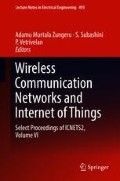Abstract
Wireless sensor networks have gained immense significance and popularity in modern technology especially as a result of emerging concepts like the Internet of Things (IoT). These networks are usually under constant pressure to scale-up in order to meet the ever-growing demand. Under such situations, it is often required to connect two existing adjacent, but independent, networks so that they form a single larger network. Some of the networks may even have mobile nodes. This paper proposes an effective method for placing a bridge node in the intersection of coverage region of two networks using a combination of Steiner tree algorithm and concept of edge nodes—Edge-based Three-Point Steiner (EdTPS) tree—such that communication across the network can be carried out with the shortest possible path.
Access this chapter
Tax calculation will be finalised at checkout
Purchases are for personal use only
References
Derek RD, Michael LO (2002) Two heuristics for the Euclidean Steiner tree problem. J Glob Optim 95–106
Gröpl C, Hougardy S, Nierhoff T, Prömel H (2001) Approximation algorithms for the Steiner tree problem in graphs. In: Cheng X, Du D-Z (eds) Steiner trees in industry. Kluwer, Norwell, pp 235–279
Zelikovsky A (1993) An 11/6-approximation algorithm for the network Steiner problem. Algorithmica 9:463–470
Berman P, Ramaiyer V (1994) Improved approximations for the Steiner tree problem. J Algorithms 17:381–408
Karpinski M, Zelikovsky A (1997) New approximation algorithms for the Steiner tree problems. J. Comb. Optim. 1:47–65
Liu L, Song Y, Zhang H, Ma H, Vasilakos AV (2015) Physarum optimization: a biology-inspired algorithm for the Steiner tree problem in networks. IEEE Trans Comput 64(3):818–831. https://doi.org/10.1109/tc.2013.229
Cong J, Kahng A, Leung K (1998) Efficient algorithms for the minimum shortest path Steiner arborescence problem with applications to VLSI physical design. IEEE Trans Comput Aided Des Integr Circ Syst 17(1):24–39
Cheng X, Du D (2001) Steiner trees in industries. Springer, Berlin
Oliveira C, Pardalos P (2005) A survey of combinatorial optimization problems in multicast routing. Comput Oper Res 32(8):1953–1981
Wang W, Li X, Wang Y (2004) Truthful multicast in selfish wireless networks. In: Proceedings of the 10th Annual International Conference on Mobile Computing and Networking (Mobi-Com’04), Sept 26/Oct 1, 2004, pp 245–259
Misra S, Hong S, Xue G, Tang J (2010) Constrained relay node placement in wireless sensor networks: formulation and approximations. IEEE/ACM Trans Netw 18(2):434–447
Mao X, Miao X, He Y, Zhu T, Wang J, Dong W, Li X, Liu Y (2012) CitySee: urban CO2 monitoring with sensors. In: Proceedings of IEEE International Conference on Computer Communications (INFOCOM), pp 1611–1619
do Nascimento MZ, Batista VR, Coimbra WR (2015) An interactive programme for weighted Steiner trees. J Phys (Conference Series 574 (2015)) 012073. https://doi.org/10.1088/1742-6596/57
Author information
Authors and Affiliations
Corresponding author
Editor information
Editors and Affiliations
Rights and permissions
Copyright information
© 2019 Springer Nature Singapore Pte Ltd.
About this paper
Cite this paper
Sundar, S., Balakrishnan, V., Kumar, R., Kittur, H.M. (2019). Shortest Path Solution to Wireless Sensor Networks Using Edge-Based Three-Point Steiner Tree Concept. In: Zungeru, A., Subashini, S., Vetrivelan, P. (eds) Wireless Communication Networks and Internet of Things. Lecture Notes in Electrical Engineering, vol 493. Springer, Singapore. https://doi.org/10.1007/978-981-10-8663-2_6
Download citation
DOI: https://doi.org/10.1007/978-981-10-8663-2_6
Published:
Publisher Name: Springer, Singapore
Print ISBN: 978-981-10-8662-5
Online ISBN: 978-981-10-8663-2
eBook Packages: EngineeringEngineering (R0)

